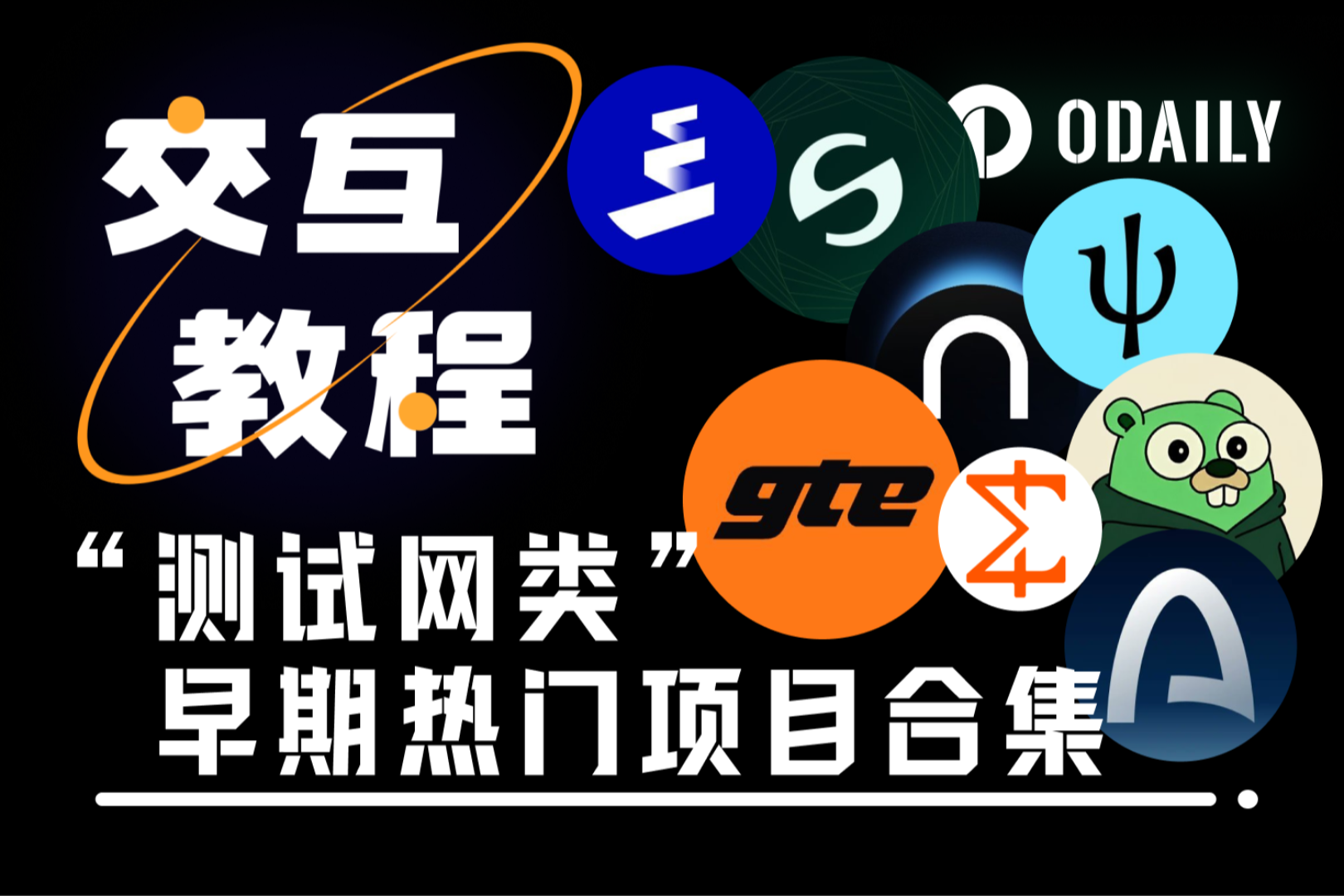Why is Aethir, which quickly recovered from the "10.11" crash, worth betting on?
- 核心观点:Aethir是去中心化GPU云算力龙头。
- 关键要素:
- 年经常性收入1.66亿美元,增长13倍。
- 全球部署43.5万个GPU容器,覆盖93国。
- SLA服务稳定性达99.31%,行业领先。
- 市场影响:推动去中心化算力被主流市场接受。
- 时效性标注:中期影响
Original | Odaily Planet Daily ( @OdailyChina )
By Golem ( @web3_golem )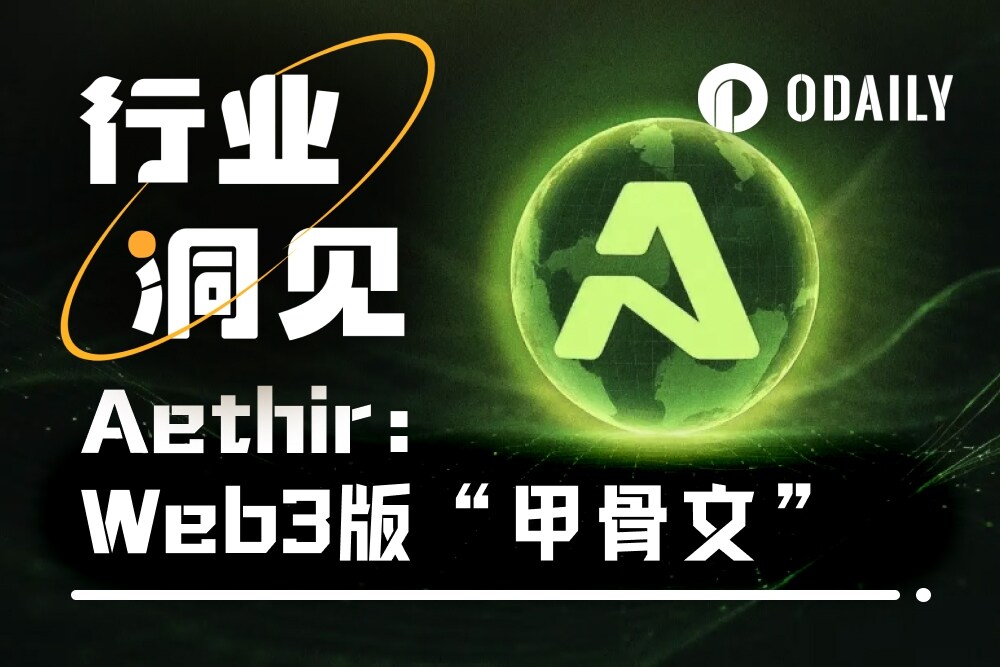
AI and cloud computing are the underlying narratives of this era's technology. In early September, Larry Ellison's net worth even briefly surpassed Musk to become the world's richest man, thanks to Oracle's AI/cloud contract performance exceeding expectations. The AI industry's robust demand for high-performance computing and cloud services has also intensified competition among upstream GPU computing providers. In the future, GPU computing providers that can provide cheaper, higher-quality computing resources and serve more small and medium-sized enterprises are poised to win in the market and attract investors.
Aethir, a distributed GPU cloud computing provider, is at the forefront of this trend. Aethir is dedicated to aggregating enterprise-grade GPUs into a globally shared computing network, providing high-quality, cost-effective computing resources to AI and cloud gaming companies. Currently, Aethir has over 435,000 high-performance GPU containers deployed globally, covering 93 countries and regions, and serving over 150 companies and customers.
In the secondary market, Aethir is also gradually gaining value. Throughout September, the ATH price continued to rise, increasing by over 63% in September, reaching a new high since February 2025. The ATH price also suffered a significant drop on October 11, dipping to $0.22, but subsequently recovered and temporarily stabilized around $0.045. The sharp drop in the cryptocurrency market has not changed Aethir's fundamentals, and its value remains low. As traditional markets gradually understand the advantages of decentralized cloud computing power, and as global regulators shift their one-size-fits-all approach to the crypto industry and clarify the essential differences between utility tokens and securities, Aethir may become the next "Oracle."
The value behind Aethir
In Web 3, product-market fit (PMF) is a crucial factor for a project's success, not just a strong narrative. From a business and long-term perspective, PMF can even determine a project's life or death. The short-term market FOMO (Fear of Momentum) caused by narratives will eventually dissipate. Without PMF, a project lacks a stable and sustainable business model and often ends up simply launching a token.
Aethir is one of the few projects in the cryptocurrency world that combines compelling narratives with strong product-market fit (PMF). Aethir doesn't rely on selling tokens for revenue; its primary revenue stream comes from enterprise clients in sectors like AI and cloud gaming that have a steady demand for high-performance computing resources. Therefore, Aethir's revenue stream is independent of the cryptocurrency market's bull and bear cycles, which is a key factor supporting its price.
While the Web 3 narrative has shifted this year to DATs and RWAs, Aethir has continued to deliver strong revenue results. In Q3 2025, Aethir's revenue exceeded $39.8 million, a 22% quarter-over-quarter increase. Its average monthly revenue reached $13.29 million, a record high for the company, and its revenue/market cap ratio reached 14.46% (industry average: 8–23%).
Aethir's GPU Dashboard data shows that its annual recurring revenue (ARR) has reached $166 million to date, a 13-fold increase compared to the same period last year. This demonstrates that Aethir's distributed GPU cloud computing subscriptions have seen a substantial increase this year, and its customer base is continuously expanding.
Aethir disclosed that in the first half of this year, its partners and customers exceeded 150, including several innovative Web 2 AI companies such as Kluster.ai, Attentions.ai, and Mondrian AI. Aethir's computing infrastructure currently covers 93 countries and regions, with over 435,000 high-performance GPU containers deployed, covering mainstream models such as NVIDIA H100, H200, B200, and A100, meeting the needs of enterprise customers at different development stages.
Meanwhile, according to Aethir's GPU Dashboard , Aethir's distributed GPU cloud computing power has reached 32,914,556 TFlops, equivalent to over 490,000 NVIDIA H100s, valued at over tens of billions of dollars. In terms of available GPU scale alone, Aethir rivals a handful of global giants capable of large-scale LLM training and highly concurrent inference, placing it among the world's top enterprise-class computing power providers.

Depin's competitive advantage: SLA service terms stability reaches 99.31%
" Aethir is currently the only Depin project in Web 3 that can provide stable services to enterprise-level customers ," said Aethir co-founder Mark when talking about Aethir's competitive advantages in the Depin track.
Mark's confidence stems from the fact that, in addition to possessing enterprise-grade computing resources, Aethir also has a Service Level Agreement (SLA). In Q3 2025, Aethir's SLA stability reached 99.31%. An SLA is a written commitment between a service provider and a customer regarding service availability, performance, responsiveness, support, and compensation. It clearly spells out the level of service customers expect and stipulates compensation or other procedures if the service doesn't meet the agreed standards.
SLAs aren't just marketing rhetoric. For a company providing enterprise-level services, having an SLA formalizes its commitment to customers regarding service quality, response times, and compensation policies. This not only demonstrates trust and professionalism, but also serves as a legal, financial, and operational responsibility. Enterprises prioritize providers with SLAs when selecting service providers.
In the traditional B2B sector, SLAs are almost standard. However, in the emerging industries of Depin and decentralized cloud computing, unstable service quality and poor performance are widely criticized. Aethir is the first decentralized cloud computing service provider to offer SLAs. This not only demonstrates that Aethir has overcome Depin's shortcomings, achieving a mature and systematic business model, but also provides Aethir with a significant competitive advantage.
"Aethir does things very differently from other Depin projects. Io.net primarily leverages distributed GPU resources to solve simple AI or machine learning tasks; Render provides 3D rendering services for consumer-level computing connections; Grass leverages distributed network resources to mine points, while Aster focuses on providing enterprise-level services in areas like gaming and AI at the software level." Aethir co-founder Mark explained the differences between Aethir and other Depin projects.
A comprehensive business model also makes sustainable enterprise revenue a core advantage for Aethir . Aethir's annual recurring revenue (ARR) has reached $166 million. According to DePIN Pulse data, Render's ARR is only $3,044, and io.net's ARR is only $11.31 million. Furthermore, Aethir's protocol revenue has grown steadily since Q3 2024, unaffected by the cryptocurrency market's bull and bear cycles.
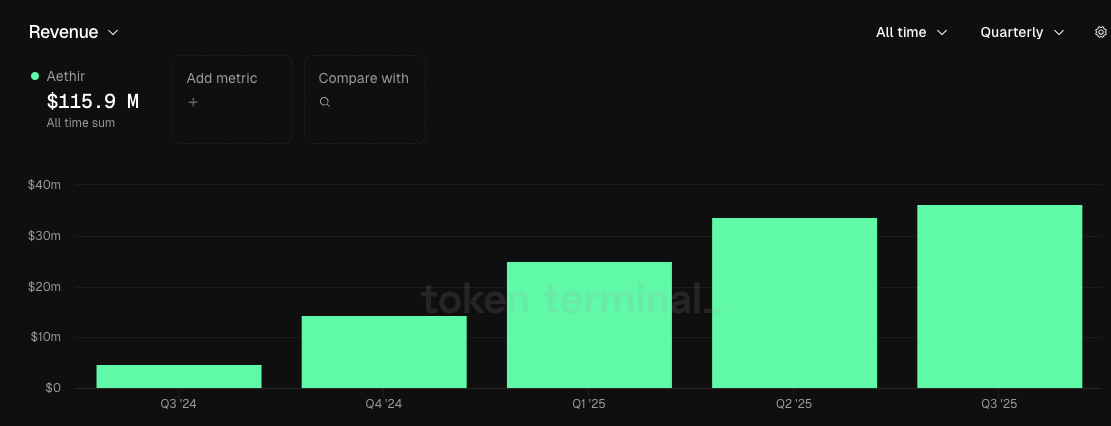
As of now, Aethir has generated $115.9 million in revenue, with its revenue in the past 30 days reaching $12.8 million, surpassing Ethereum and Lido.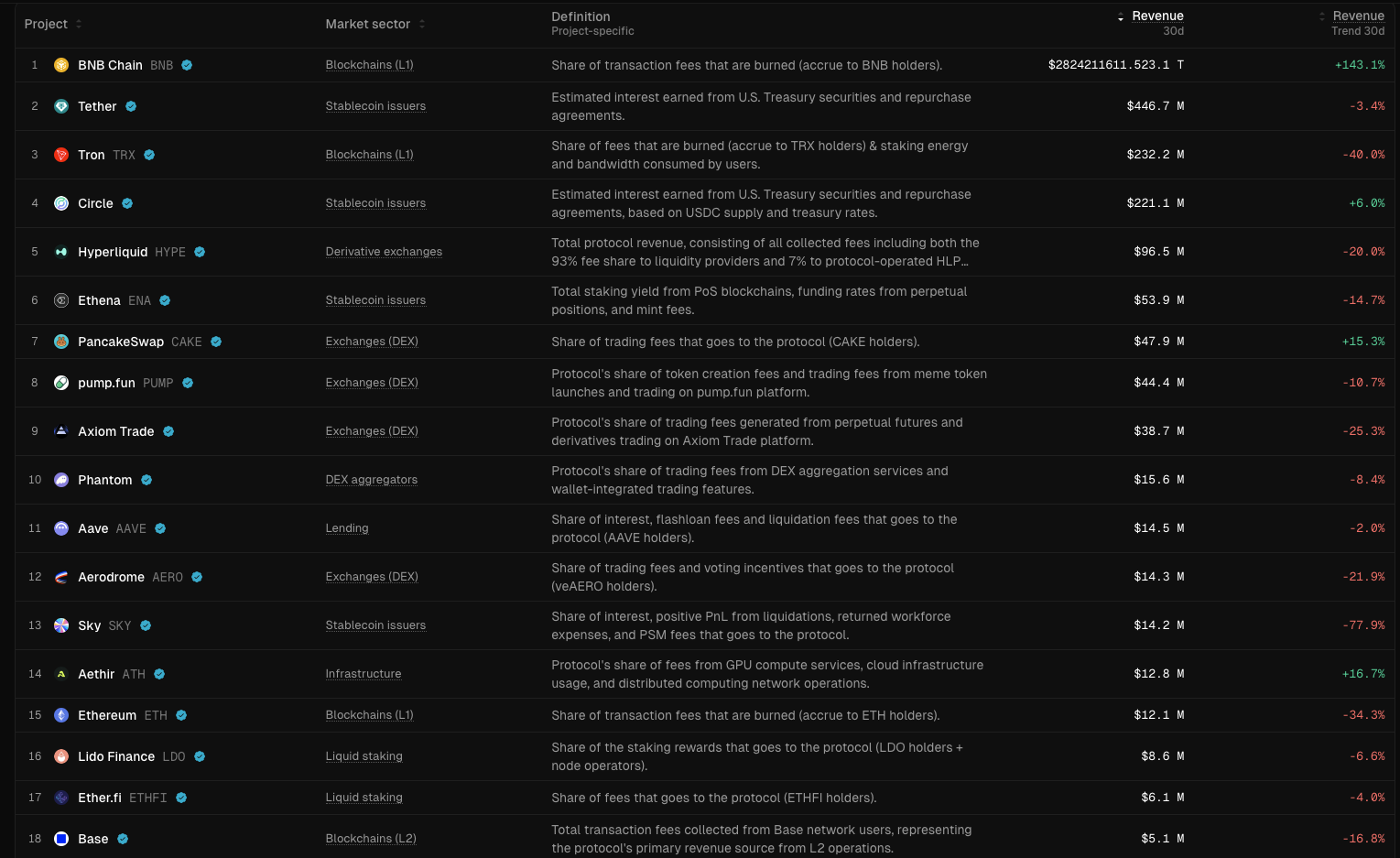
Aethir's Pricing Advantage and the Financialization of Computing Power
Aethir's true competitors are Web 2's centralized computing and cloud service companies, and its greatest advantage lies in its competitive pricing. " For example, right now, the price on our platform is about one-tenth of AWS's ." As shown in the figure below, while Aethir's hourly GPU price is significantly lower than that of Google, AWS, and Oracle, it also offers enterprise-grade computing resources for large-scale LLM training and cloud game rendering.
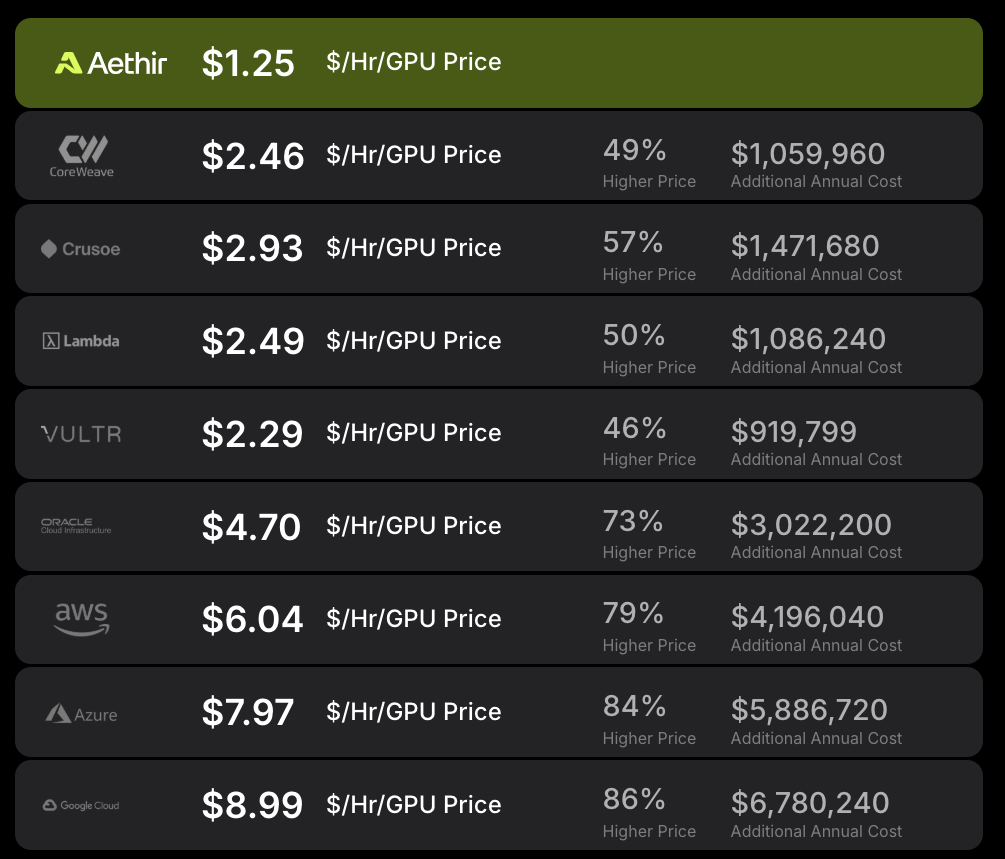
This is primarily due to the advantages of Aethir's distributed network. Its decentralized operating model eliminates the need to purchase GPU hardware, bear the construction and operating costs of data centers, and incur the associated corporate overhead. This reduces costs by 80% compared to traditional Web 2 computing providers. In the traditional market, these costs are ultimately passed on to businesses that purchase or rent computing power. However, on Aethir's network, businesses connect directly with computing power providers, reducing intermediary costs and facilitating fair competition, enabling small and medium-sized businesses and startups to obtain the computing resources they need at a lower price.
Aethir primarily serves Web 2 AI and gaming companies. However, even good wine needs a bush. While decentralized computing power offers pricing advantages, some companies may be wary of the risks due to a lack of understanding of the operational mechanisms of decentralized cloud computing. Furthermore, from a compliance perspective, Aethir's use of cryptocurrency for service payments also challenges compliance. For brick-and-mortar businesses, due to varying definitions and regulatory approaches to cryptocurrency, using cryptocurrency for service settlements may raise issues such as anti-money laundering, payment licensing, and taxation.
This is actually the fundamental difference between "tokenized pricing" and "financialized computing power." In the traditional computing power market, parties A and B typically settle service fees in fiat currency. Even if tokens are used internally for pricing, those tokens cannot circulate in the secondary market. However, in the Aethir network, the platform token ATH is used to settle service fees. ATH is a volatile cryptocurrency that can circulate freely in the secondary market. This has historically been the largest regulatory gray area in the decentralized cloud computing space and has hindered Aethir's business expansion.
Fortunately, with the easing of US regulations on the crypto industry this year and the SEC's gradual clarification of the boundaries between securities and crypto utility tokens, AI companies are increasingly accepting decentralized computing power. While Web 2 giants remain divided on whether computing power should be centrally provided, they have long explored using cryptocurrencies for service payments. In 2022, Google piloted a program through Coinbase that allowed some customers to pay for cloud services with cryptocurrencies.
Meanwhile, amidst the proliferation of DATs, traditional finance is becoming increasingly receptive to decentralized computing power tokens. Aethir is also at the forefront of the financialization of computing power. On September 29th, Aethir announced a partnership with Predictive Oncology (NASDAQ: POAI) to launch the $344 million ATH Digital Asset Treasury (DAT). This is the first strategic reserve centered around GPU computing power.
Aethir is rapidly expanding its GPU infrastructure from Q4 2025 to 2026, acquiring new cloud hosts globally to meet the exponential growth in enterprise AI demand. By Q1 2026, Aethir plans to more than double its global computing capacity, further solidifying its position as a leading global GPU cloud service provider driving the AI economy.
The actual revenue generated will be used to repurchase ATH tokens. Aethir launched a $45 million DAT repurchase plan on October 11, with a time period of 45 days.
Therefore, Mark calls Aethir DAT a work of art that represents a true fusion of capital markets and token economics, in perfect sync.
I believe that in the near future, as decentralized cloud computing power becomes increasingly important in promoting the development of AI companies, global regulators will actively formulate relevant policies to promote the healthy development of the industry. As a leader in decentralized computing power, Aethir's value will be re-evaluated by capital.
ATH's positive flywheel
The success of a Web 3 project not only depends on narrative and PMF, but also on good token economics. Aethir's token economics has created a positive flywheel for ATH, becoming the long-term value support for ATH's price.
First, ATH, as a token for Aethir's computing power usage, is deeply integrated into the operation of the Aethir network. Enterprise clients using GPU computing resources must settle their payments with ATH tokens, which gives the token practicality and creates a fee-sharing system similar to that of public blockchains. However, the difference is that AI model training is a long-term process, requiring both computing power and stability. This means that each customer represents a commitment to long-term ATH purchases.
On the other hand, containers that provide GPU computing resources in Aethir must pledge ATH to provide services. This cleverly integrates ATH into the reward and punishment system to maintain system security and also reduces the circulation of tokens in the market.
At the same time, Aethir DAT will not sell the tokens after repurchasing them, but will transfer them to the DAT Treasury. These tokens will be used to generate income by staking, or to generate income for corporate customers to book calculations on the network, reducing the circulation of ATH in the market.
The expansion of the Aethir network’s GPU computing power means that more Aethir will be staked. According to Aethir’s GPU Dashboard , over 17.4 ATHs are currently staked, with cloud servers accounting for 54% of this.
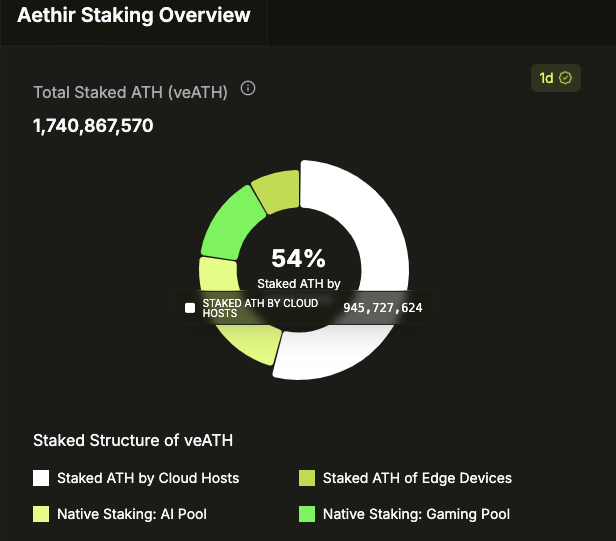
Aethir focuses on enterprise-level economic model design, which is extremely attractive to cloud hosts. At the same time, 80% of the profits are given to the cloud hosts and 20% to the Aethir Foundation. In addition, the continuous reduction in the circulation of tokens and the increase in the value of token rewards allow Aethir to expand the number of cloud hosts on the platform at a very fast speed.
With the entry of a large number of cloud hosts, the increased computing power and low prices will attract more large customers, thereby creating more revenue and excellent ARR. The cloud hosts will receive more rewards, the GPU supply will further expand, and the ATH cloud host pledge rate and intrinsic value support will be further enhanced.
Aethir: A viable business case for combining Web 3 and AI
AI represents the advancement of productivity in this era, while Web 3 represents the transformation of production relations. However, the combination of Web 3 and AI has been repeatedly disproven in the past, with the market experiencing numerous bubbles. However, in the fields of GPU computing and cloud services, the source of AI, Aethir has found a viable business case for combining Web 3 and AI through a closed-loop business model, a global customer base, positive cash flow, and a well-designed token model.
Aethir possesses true cross-sector scalability. As the crypto industry moves toward formalization and mass adoption, while the market is currently focused on areas like stablecoins and RWAs where Web 3 is transforming traditional finance, in the AI-driven era, people will eventually realize the transformative significance of Web 3 for the AI and computing markets. When that happens, Aethir, as a leader in decentralized cloud computing, will be the first to capture the attention of investors.


